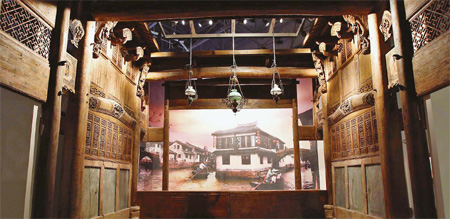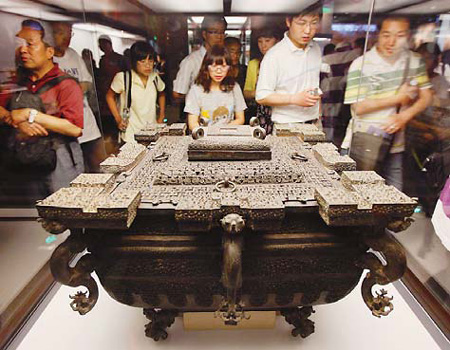Follow footprints to the past
 |
| A model of an old Chinese house was built with antique wood replete with elaborate carvings. |
 |
| The world's oldest icebox is both ingenious and beautiful. |
There is one pavilion at the Expo that eschews the future in favor of the past.
The Pavilion of Footprint demonstrates the evolution of urban life in human civilizations with ancient Roman city walls, China's first icebox and a smoke filtering lantern.
Some of the pavilion's exhibits, collected by the Shanghai Museum, were borrowed from foreign museums. For Expo visitors bored with other pavilions' audiovisual extravaganzas, this pavilion at Zone D provides a very different experience.
The pavilion features three exhibition halls, tracing the origin, development and modernization of urban life.
The ground floor exhibition hall has some side rooms with exhibitions that can be missed but are worth seeing. In one of the rooms is a life-size replica of a cave from the famous Mogao Grottoes in Dunhuang, Gansu province, where one can see vivid sculptures of the Buddha and frescos on the wall and ceiling depicting angels.
"Dunhuang embodied ancient Chinese ideals of life," said Chen Xiejun, director of Shanghai Museum. "This is the first time the sculptures have left Dunhuang."
Also exhibited are reproductions of China's largest group of Chinese Serial Bells, ancient bells of varying sizes, from Hubei Museum. These musical instruments play graceful melodies creating beautiful sounds and were an important part of ancient Chinese ceremonies. Musicians perform short 10-minute concerts every hour, on the hour.
The central exhibition hall on the second floor features ancient city models and video projections on a wall covered in precious stones.
Visitors will find one of the exhibits, a bronze double-layered box about a meter tall, looks familiar.
"This was used as a drum at the opening ceremony of the Olympics," Chen said. "But the true function of this can't be further from a percussion instrument."
This bronze box was probably the world's first icebox. Removing the giant lid reveals a smaller bronze cube.
"Ancient Chinese would put ice in the large cube and then fill the small cube with wine - of course it can also be used as a warmer when you fill the space between with hot water," Chen said.
The 2,000-year-old antique was borrowed from the National Museum of China.
Another exhibit worth highlighting is a lantern in the shape of a bird.
"It's a beautiful piece - look at the graceful curve of the bird's neck," Chen said. "But it actually functions; smoke filters through water before going out of the neck. It was quite environmental-friendly."
Visitors can see replicas of ancient cities, such as Constantinople, Troy and Amsterdam, in the exhibition halls. Movie set designers with the Shanghai Film Studio were invited to create the battlefield of Troy with the Trojan horse standing in the center.
Antique wood from dismantled old houses in rural China was collected to build models of ancient Chinese houses. The life-size reproduction of a traditional Chinese theater is striking.
Drawings by Shanghai's most acclaimed illustrator He Youzhi depict scenes in the city.
Two exhibition halls on the third floor are also easily missed but have interesting relics.
Many valuable cultural relics from the Green Vault in Dresden, Germany, are on exhibit next door to those from China's Imperial Palace. After stepping from the Green Vault hall to the Imperial Palace space, one can't help but wonder about the sharp contrast of two cultures and yet feel amazed at the beauty and brilliance of both.
 0
0 







Go to Forum >>0 Comments